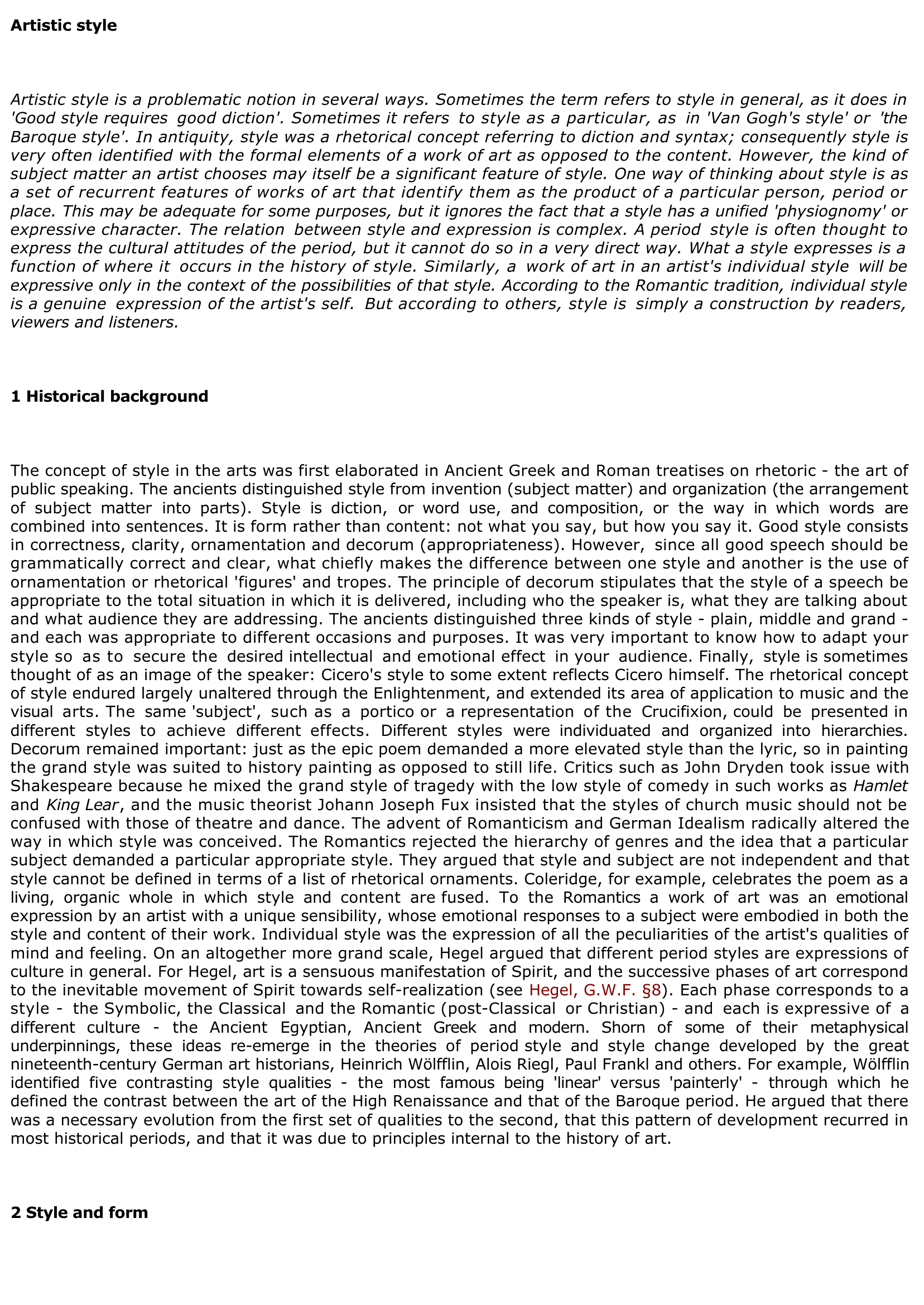Artistic style
Publié le 16/05/2020

Extrait du document
«
Artistic style
Artistic style is a problematic notion in several ways.
Sometimes the term refers to style in general, as it does in'Good style requires good diction'.
Sometimes it refers to style as a particular, as in 'Van Gogh's style' or 'theBaroque style'.
In antiquity, style was a rhetorical concept referring to diction and syntax; consequently style isvery often identified with the formal elements of a work of art as opposed to the content.
However, the kind ofsubject matter an artist chooses may itself be a significant feature of style.
One way of thinking about style is asa set of recurrent features of works of art that identify them as the product of a particular person, period orplace.
This may be adequate for some purposes, but it ignores the fact that a style has a unified 'physiognomy' orexpressive character.
The relation between style and expression is complex.
A period style is often thought toexpress the cultural attitudes of the period, but it cannot do so in a very direct way.
What a style expresses is afunction of where it occurs in the history of style.
Similarly, a work of art in an artist's individual style will beexpressive only in the context of the possibilities of that style.
According to the Romantic tradition, individual styleis a genuine expression of the artist's self.
But according to others, style is simply a construction by readers,viewers and listeners.
1 Historical background
The concept of style in the arts was first elaborated in Ancient Greek and Roman treatises on rhetoric - the art ofpublic speaking.
The ancients distinguished style from invention (subject matter) and organization (the arrangementof subject matter into parts).
Style is diction, or word use, and composition, or the way in which words arecombined into sentences.
It is form rather than content: not what you say, but how you say it.
Good style consistsin correctness, clarity, ornamentation and decorum (appropriateness).
However, since all good speech should begrammatically correct and clear, what chiefly makes the difference between one style and another is the use ofornamentation or rhetorical 'figures' and tropes.
The principle of decorum stipulates that the style of a speech beappropriate to the total situation in which it is delivered, including who the speaker is, what they are talking aboutand what audience they are addressing.
The ancients distinguished three kinds of style - plain, middle and grand -and each was appropriate to different occasions and purposes.
It was very important to know how to adapt yourstyle so as to secure the desired intellectual and emotional effect in your audience.
Finally, style is sometimesthought of as an image of the speaker: Cicero's style to some extent reflects Cicero himself.
The rhetorical conceptof style endured largely unaltered through the Enlightenment, and extended its area of application to music and thevisual arts.
The same 'subject', such as a portico or a representation of the Crucifixion, could be presented indifferent styles to achieve different effects.
Different styles were individuated and organized into hierarchies.Decorum remained important: just as the epic poem demanded a more elevated style than the lyric, so in paintingthe grand style was suited to history painting as opposed to still life.
Critics such as John Dryden took issue withShakespeare because he mixed the grand style of tragedy with the low style of comedy in such works as Hamlet and King Lear , and the music theorist Johann Joseph Fux insisted that the styles of church music should not be confused with those of theatre and dance.
The advent of Romanticism and German Idealism radically altered theway in which style was conceived.
The Romantics rejected the hierarchy of genres and the idea that a particularsubject demanded a particular appropriate style.
They argued that style and subject are not independent and thatstyle cannot be defined in terms of a list of rhetorical ornaments.
Coleridge, for example, celebrates the poem as aliving, organic whole in which style and content are fused.
To the Romantics a work of art was an emotionalexpression by an artist with a unique sensibility, whose emotional responses to a subject were embodied in both thestyle and content of their work.
Individual style was the expression of all the peculiarities of the artist's qualities ofmind and feeling.
On an altogether more grand scale, Hegel argued that different period styles are expressions ofculture in general.
For Hegel, art is a sensuous manifestation of Spirit, and the successive phases of art correspondto the inevitable movement of Spirit towards self-realization (see Hegel, G.W.F.
§8 ).
Each phase corresponds to a style - the Symbolic, the Classical and the Romantic (post-Classical or Christian) - and each is expressive of adifferent culture - the Ancient Egyptian, Ancient Greek and modern.
Shorn of some of their metaphysicalunderpinnings, these ideas re-emerge in the theories of period style and style change developed by the greatnineteenth-century German art historians, Heinrich Wölfflin, Alois Riegl, Paul Frankl and others.
For example, Wölfflinidentified five contrasting style qualities - the most famous being 'linear' versus 'painterly' - through which hedefined the contrast between the art of the High Renaissance and that of the Baroque period.
He argued that therewas a necessary evolution from the first set of qualities to the second, that this pattern of development recurred inmost historical periods, and that it was due to principles internal to the history of art.
2 Style and form.
»
↓↓↓ APERÇU DU DOCUMENT ↓↓↓
Liens utiles
- Les figures de style (Procédés d'écriture)
- Les figures de style
- Fiche figures de style
- Civil td: Style et Structure d’une décision judicaire
- Vous commenterez cette formule d'Albert Camus : « Le plus grand style en art est l'expression de la plus haute révolte. Comme le vrai classicisme n'est qu'un romantisme dompté, le génie est une révolte qui a créé sa propre mesure. »


